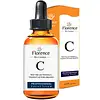What's inside
What's inside
 Key Ingredients
Key Ingredients

 Benefits
Benefits

 Concerns
Concerns

 Ingredients Side-by-side
Ingredients Side-by-side

Water
Skin ConditioningAscorbic Acid
AntioxidantCyclohexasiloxane
EmollientGlycerin
HumectantAlcohol Denat.
AntimicrobialPotassium Hydroxide
BufferingPolymethylsilsesquioxane
Polysilicone-11
Dimethicone
EmollientPropylene Glycol
HumectantPentaerythrityl Tetraethylhexanoate
EmollientC13-14 Isoparaffin
EmollientTocopherol
AntioxidantSodium Hyaluronate
HumectantHydrolyzed Hyaluronic Acid
HumectantAdenosine
Skin ConditioningAcetyl Dipeptide-1 Cetyl Ester
Skin ConditioningPEG-20 Methyl Glucose Sesquistearate
EmulsifyingPoloxamer 338
EmulsifyingSalicylic Acid
MaskingPolyacrylamide
Toluene Sulfonic Acid
Ammonium Polyacryloyldimethyl Taurate
Emulsion StabilisingXanthan Gum
EmulsifyingCaprylyl Glycol
EmollientDisodium EDTA
BHT
AntioxidantLaureth-7
EmulsifyingParfum
MaskingWater, Ascorbic Acid, Cyclohexasiloxane, Glycerin, Alcohol Denat., Potassium Hydroxide, Polymethylsilsesquioxane, Polysilicone-11, Dimethicone, Propylene Glycol, Pentaerythrityl Tetraethylhexanoate, C13-14 Isoparaffin, Tocopherol, Sodium Hyaluronate, Hydrolyzed Hyaluronic Acid, Adenosine, Acetyl Dipeptide-1 Cetyl Ester, PEG-20 Methyl Glucose Sesquistearate, Poloxamer 338, Salicylic Acid, Polyacrylamide, Toluene Sulfonic Acid, Ammonium Polyacryloyldimethyl Taurate, Xanthan Gum, Caprylyl Glycol, Disodium EDTA, BHT, Laureth-7, Parfum
Water
Skin ConditioningSodium Ascorbyl Phosphate
AntioxidantAloe Barbadensis Leaf Juice
Skin ConditioningGlycerin
HumectantFerulic Acid
AntimicrobialHydrolyzed Hyaluronic Acid
HumectantSodium Hyaluronate
HumectantArginine
MaskingTaraxacum Officinale Extract
Skin ConditioningCentella Asiatica Extract
CleansingEquisetum Arvense Extract
AstringentCitrus Aurantium Amara Flower Water
MaskingHamamelis Virginiana Leaf Extract
Skin ConditioningSimmondsia Chinensis Seed Oil
EmollientCitrus Aurantium Dulcis Peel Oil
MaskingPhytic Acid
Benzyl Alcohol
PerfumingTocopheryl Acetate
AntioxidantPolyglyceryl-4 Caprate
EmulsifyingLimonene
PerfumingXanthan Gum
EmulsifyingEthylhexylglycerin
Skin ConditioningPotassium Sorbate
PreservativeSodium Benzoate
MaskingWater, Sodium Ascorbyl Phosphate, Aloe Barbadensis Leaf Juice, Glycerin, Ferulic Acid, Hydrolyzed Hyaluronic Acid, Sodium Hyaluronate, Arginine, Taraxacum Officinale Extract, Centella Asiatica Extract, Equisetum Arvense Extract, Citrus Aurantium Amara Flower Water, Hamamelis Virginiana Leaf Extract, Simmondsia Chinensis Seed Oil, Citrus Aurantium Dulcis Peel Oil, Phytic Acid, Benzyl Alcohol, Tocopheryl Acetate, Polyglyceryl-4 Caprate, Limonene, Xanthan Gum, Ethylhexylglycerin, Potassium Sorbate, Sodium Benzoate
 Reviews
Reviews

Ingredients Explained
These ingredients are found in both products.
Ingredients higher up in an ingredient list are typically present in a larger amount.
Glycerin is already naturally found in your skin. It helps moisturize and protect your skin.
A study from 2016 found glycerin to be more effective as a humectant than AHAs and hyaluronic acid.
As a humectant, it helps the skin stay hydrated by pulling moisture to your skin. The low molecular weight of glycerin allows it to pull moisture into the deeper layers of your skin.
Hydrated skin improves your skin barrier; Your skin barrier helps protect against irritants and bacteria.
Glycerin has also been found to have antimicrobial and antiviral properties. Due to these properties, glycerin is often used in wound and burn treatments.
In cosmetics, glycerin is usually derived from plants such as soybean or palm. However, it can also be sourced from animals, such as tallow or animal fat.
This ingredient is organic, colorless, odorless, and non-toxic.
Glycerin is the name for this ingredient in American English. British English uses Glycerol/Glycerine.
Learn more about GlycerinHydrolyzed Hyaluronic Acid is a form of hyaluronic acid. It is created by the hydrolysis of hyaluronic acid with a high molecular weight. Once created, Hydrolyzed Hyaluronic Acid has a low molecular weight.
Low molecular weight HA has been shown to hydrate and increase elasticity of the skin. Increasing elasticity is also associated with reduction of wrinkle depth.
One study found topical low molecular weight hyaluronic acid may be considered for the treatment of rosacea in the adult population. However, we always recommend speaking with a professional about your skin concerns.
Hyaluronic acids are a humectant. This means they draw moisture from the air. Hyaluronic acids help moisturize, soothe, and protect the skin.
Read more about other common forms of hyaluronic acid:
Learn more about Hydrolyzed Hyaluronic AcidSodium Hyaluronate is hyaluronic acid's salt form. It is commonly derived from the sodium salt of hyaluronic acid.
Like hyaluronic acid, it is great at holding water and acts as a humectant. This makes it a great skin hydrating ingredient.
Sodium Hyaluronate is naturally occurring in our bodies and is mostly found in eye fluid and joints.
These are some other common types of Hyaluronic Acid:
Learn more about Sodium HyaluronateWater. It's the most common cosmetic ingredient of all. You'll usually see it at the top of ingredient lists, meaning that it makes up the largest part of the product.
So why is it so popular? Water most often acts as a solvent - this means that it helps dissolve other ingredients into the formulation.
You'll also recognize water as that liquid we all need to stay alive. If you see this, drink a glass of water. Stay hydrated!
Learn more about WaterXanthan gum is used as a stabilizer and thickener within cosmetic products. It helps give products a sticky, thick feeling - preventing them from being too runny.
On the technical side of things, xanthan gum is a polysaccharide - a combination consisting of multiple sugar molecules bonded together.
Xanthan gum is a pretty common and great ingredient. It is a natural, non-toxic, non-irritating ingredient that is also commonly used in food products.
Learn more about Xanthan Gum